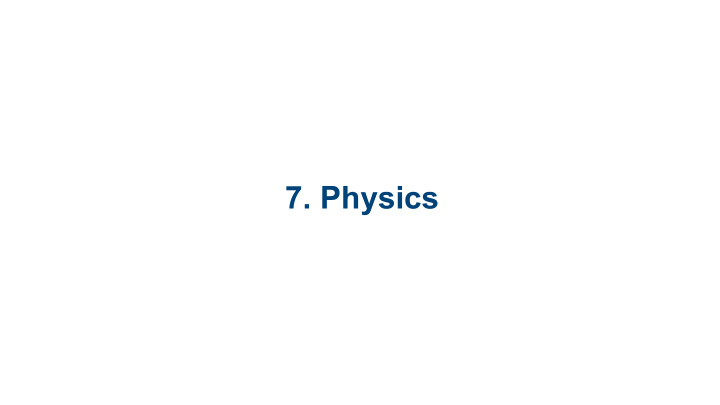



7. Physics
7.1 Heat and Thermodynamics 7.2 States of Matter, Density, and Gravity 7.3 Classical Mechanics and Relativity
7.1 Heat and the Laws of Thermodynamics
Heat is energy that flows from an object and can increase the temperature of an object that is cooler. Temperature is a measure of the average kinetic energy of that object.
The particles in a substance are always moving – even in a solid. The temperature at which the motion of the particles stops is called absolute zero, or 0 Kelvin, though it has never been reached by any substance.
There are three common methods of heat transfer: 1) Radiation 2) Convection 3) Conduction
Different materials have different capacities for storing energy. It takes water 20 minutes to heat to 75 degrees, 2 minutes for copper to reach the same temperature. Water stays hotter longer – it holds the heat.
The measure of this ability to store energy is called specific heat. (the amt. of energy to raise 1g by 1 degree C)
The specific heat of water is 4.2 J/(g x C o ). What mass of water will be heated by 10 degrees when 840J of heat is added? Q = cm Δ T Q – heat added c – specific heat m – mass Δ T – change in temperature
The specific heat of water is 4.2 J/(g x o c). What mass of water will be heated by 10 degrees when 840J of heat is added? Q = cm Δ T Q / (c Δ T ) = m (840J) / (4.2 J/(g x o C) x 10 o C = m = 20g
The laws of thermodynamics explain the relationship between heat and energy in the universe. There are four laws we will discuss.
1) The law of conservation of matter and energy – matter and energy can neither be made nor destroyed 2) The law of entropy – whenever energy is exchanged in a process, some energy becomes unavailable for use
3) The law of absolute zero – absolute zero cannot be attained by any system 0) The zeroth law – whenever two bodies are in contact, they will move toward a state of thermodynamic equilibrium where both are at the same temperature
7.2 States of Matter, Density, and Gravity
All matter has physical properties that can be observed, and typically exists in one of four fundamental states, or phases: solid, liquid, gas, or plasma.
Solid – definite volume and shape, strong attractions Liquid – definite volume, no definite shape Gas – no definite volume, no definite shape, weak attractions
Ideal Gas Law PV = nRT P – pressure V – volume n – amount of gas R – gas constant T – temperature of the gas
Pressure and volume are proportional to temperature, assuming nR is constant. Pressure and volume are inversely proportional to each other – if one goes up, the other must drop
Important Temperatures Melting point – solid to liquid Freezing point – liquid to solid Boiling point – liquid to gas Heat of fusion – melt 1 kg of solid Heat of vaporization – 1 kg liquid to gas Condensation – gas to liquid Evaporation – liquid to gas
Density is a measure of matter per units of volume. D = m/v
Pressure is a measure of force per units of area. Pressure in a gas can impact it’s density, as a gas will always spread, or compress, to fill the container it is in. (liquids and solids are less responsive to pressure)
The force of gravity (F) is a measure of both mass(m) and pressure. The weight of an object is a function of the mass and the pull of gravity upon it. The force of gravity (F) = Mass (m) x acceleration caused by gravity (g) or F = mg
The acceleration caused by gravity is 9.8m/s 2 The weight of an object = mg A falling object will continue to accelerate until the force of air resistance equals the acceleration due to gravity – a point called terminal velocity. This is independent of the weight of the object.
7.3 Classical Mechanics and Relativity
Mechanics is the study of objects in motion. Classical mechanics studies objects larger than atoms but slower than light.
Newton’s Laws of Motion: 1) Law of Inertia – an object at rest (or in motion) will stay at rest (or in motion) until acted upon by another object or force
Newton’s Laws of Motion: 2) Law of Force vs. Mass – the rate of change of an object is proportional to its mass and the force acting upon it, or F = ma
Newton’s Laws of Motion: 3) Law of Action and Reaction – interactions between two objects produces two forces that are equal in magnitude and opposite in direction
Work – movement of mass over distance (w=fd) Speed – rate of change of distance traveled (s=d/t) Displacement – change in position, noting the starting point and the end point (not always = distance) Velocity – rate of change of displacement (v = d/t)
Friction – rubbing motion that acts against motion between two touching surfaces Acceleration – rate of change of velocity (a=v2-v1/t2-t1) Momentum – product of mass and velocity Force – push or pull exerted
Si Units – International System Mass – kilograms Length – meters Time – seconds Volume – liters
Einstein’s theory of relativity summed up states 1) The speed of light is constant 2) The laws of physics are the same for all inertial frames of reference E = mc 2
Recommend
More recommend